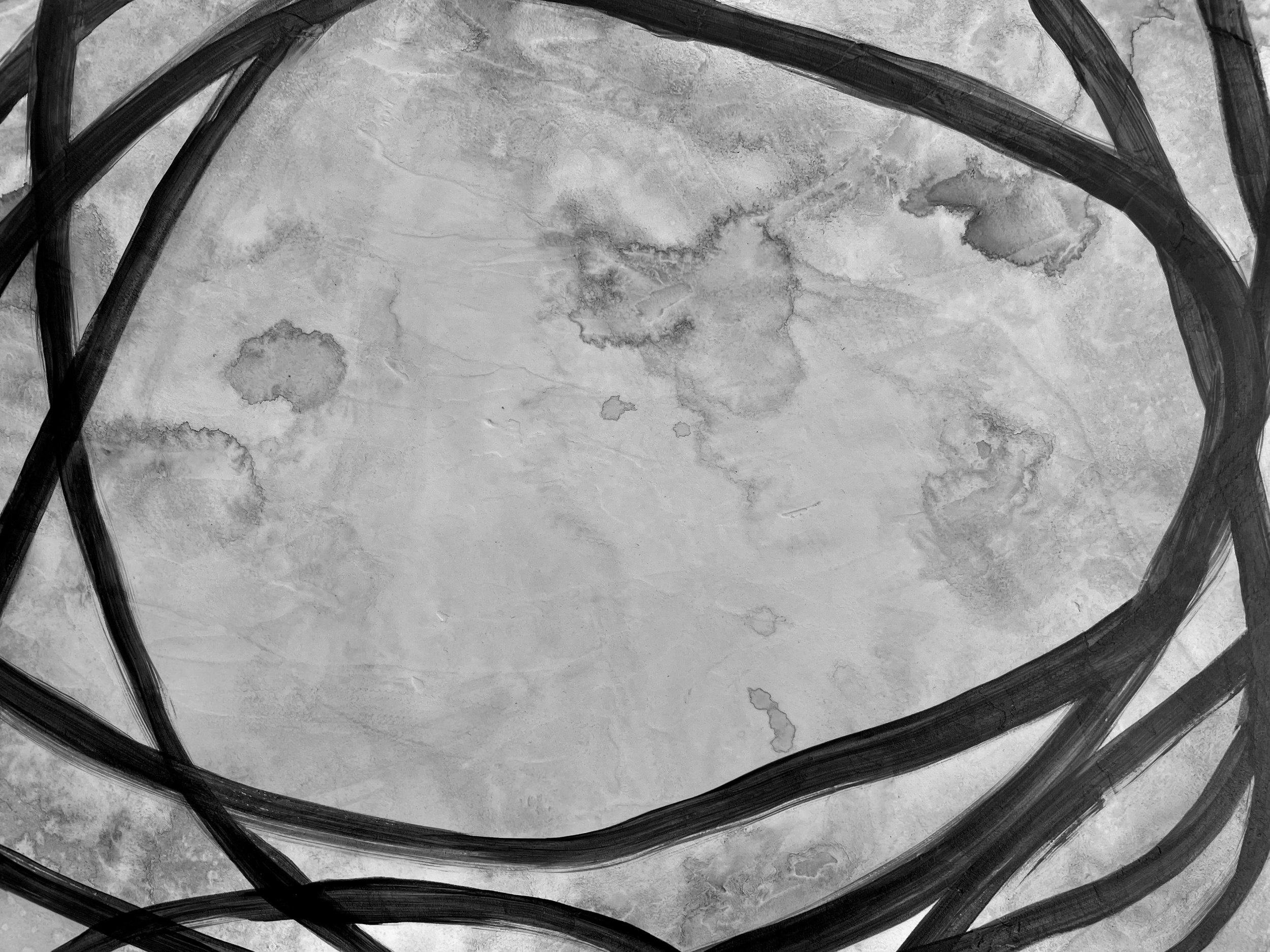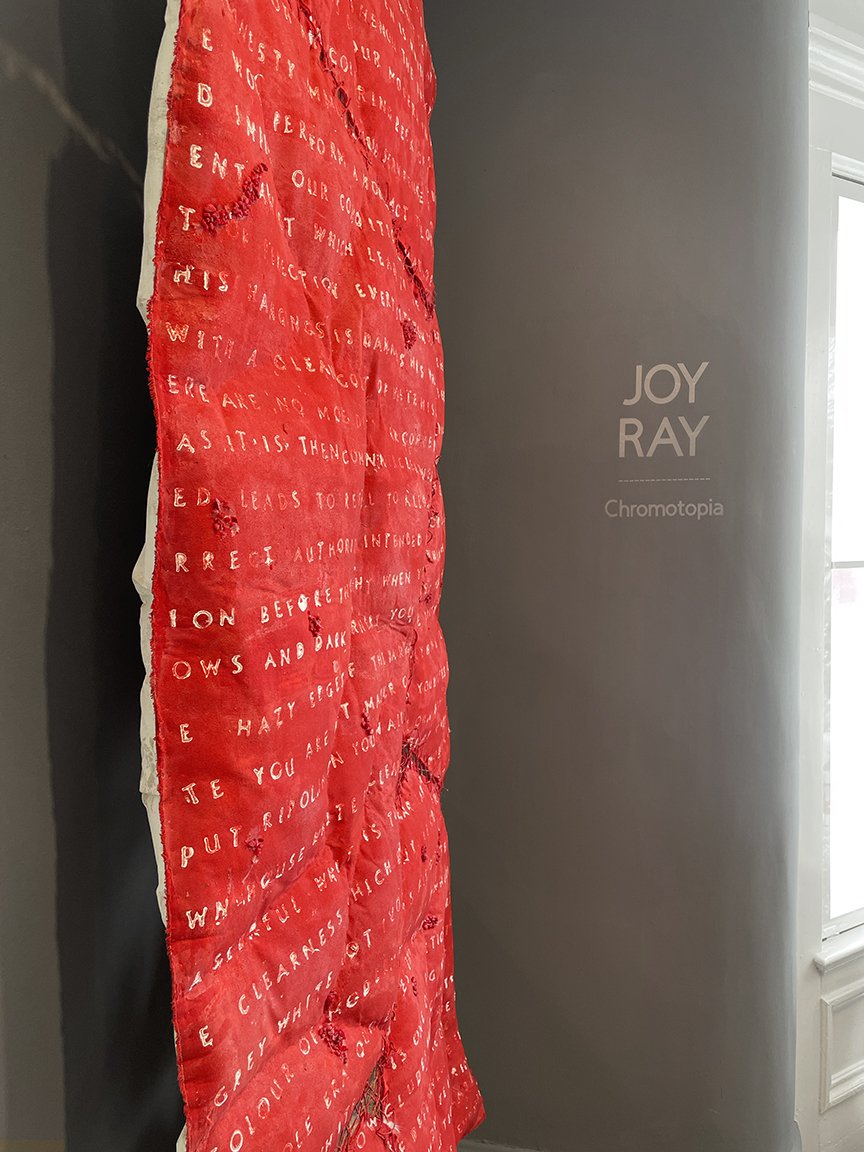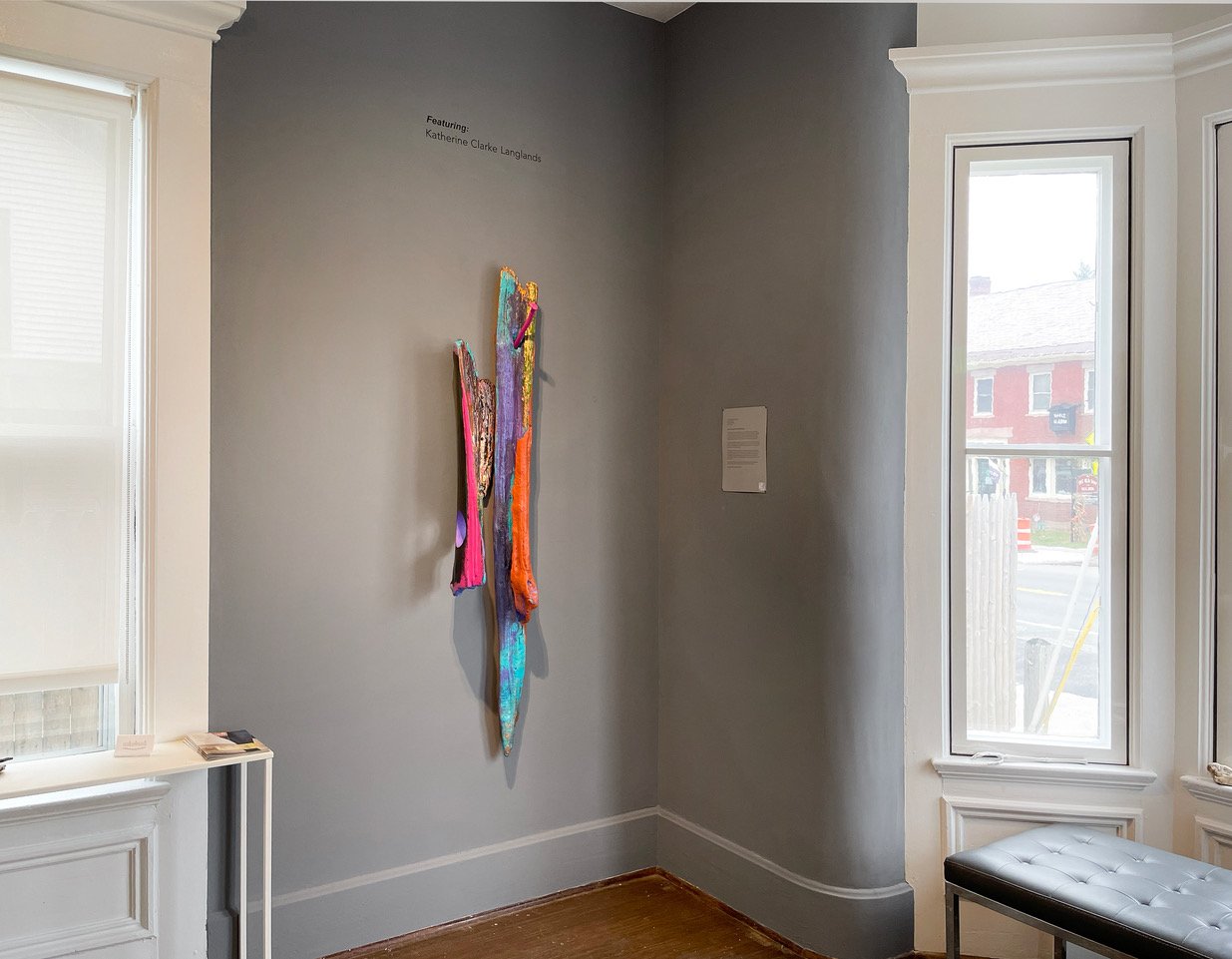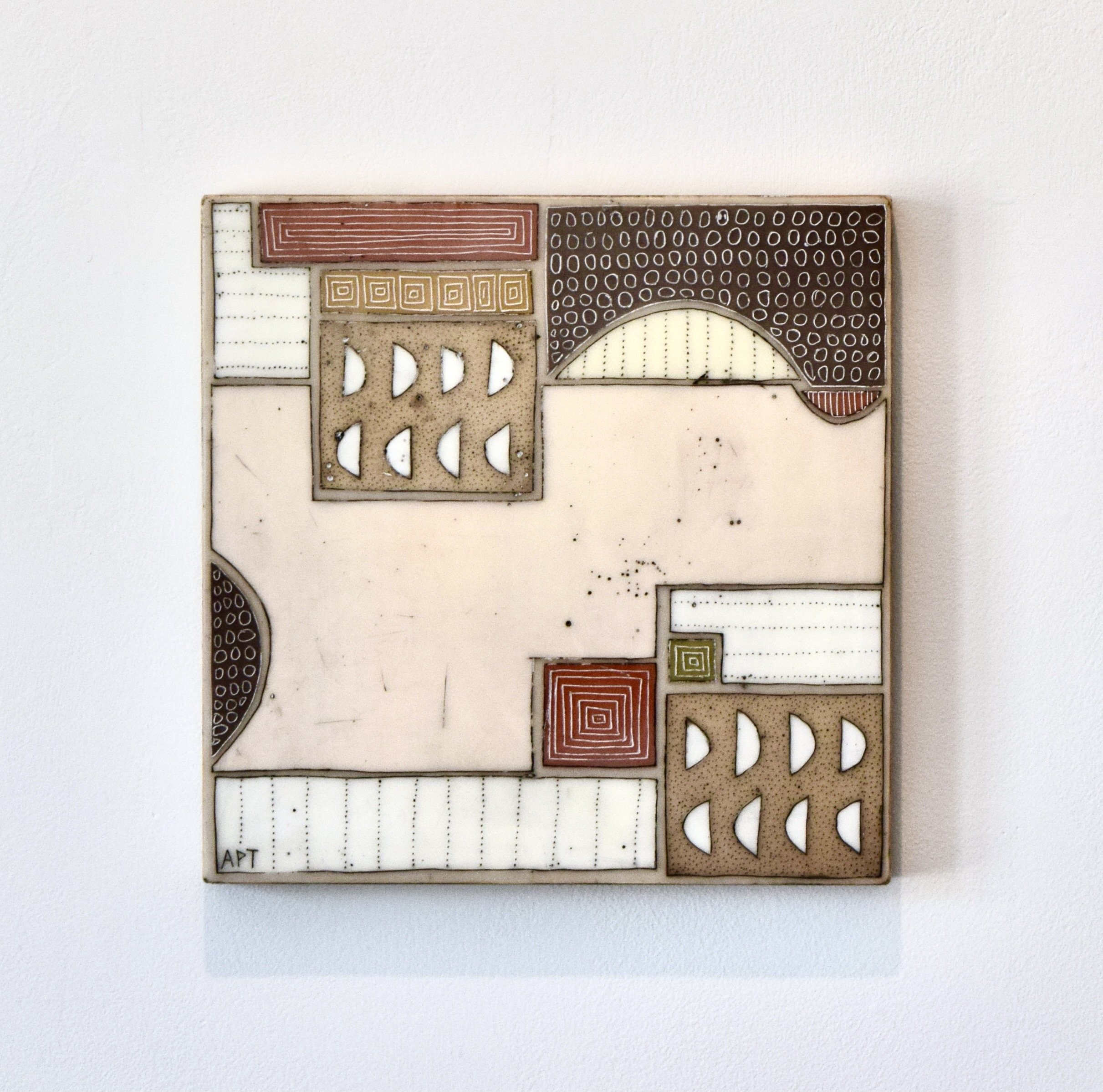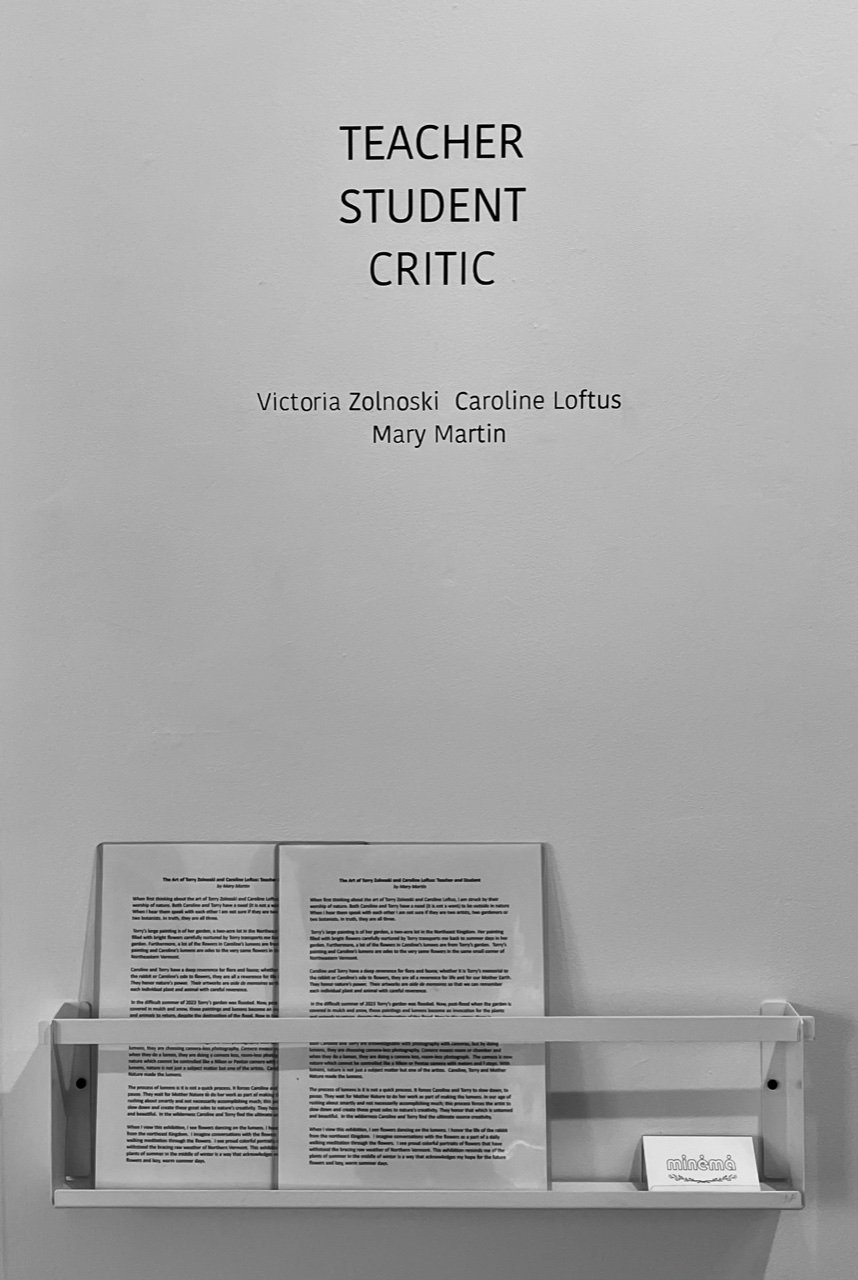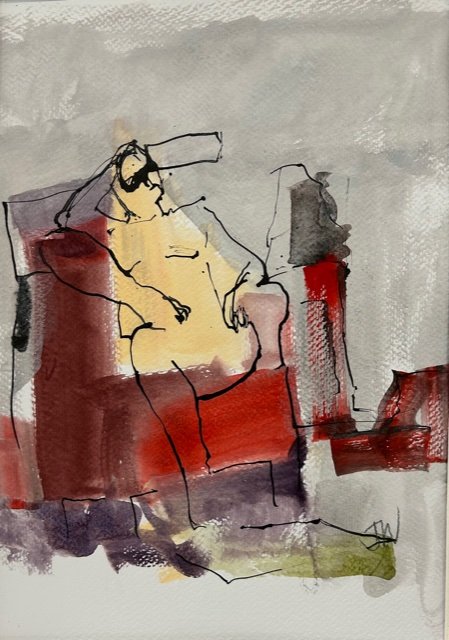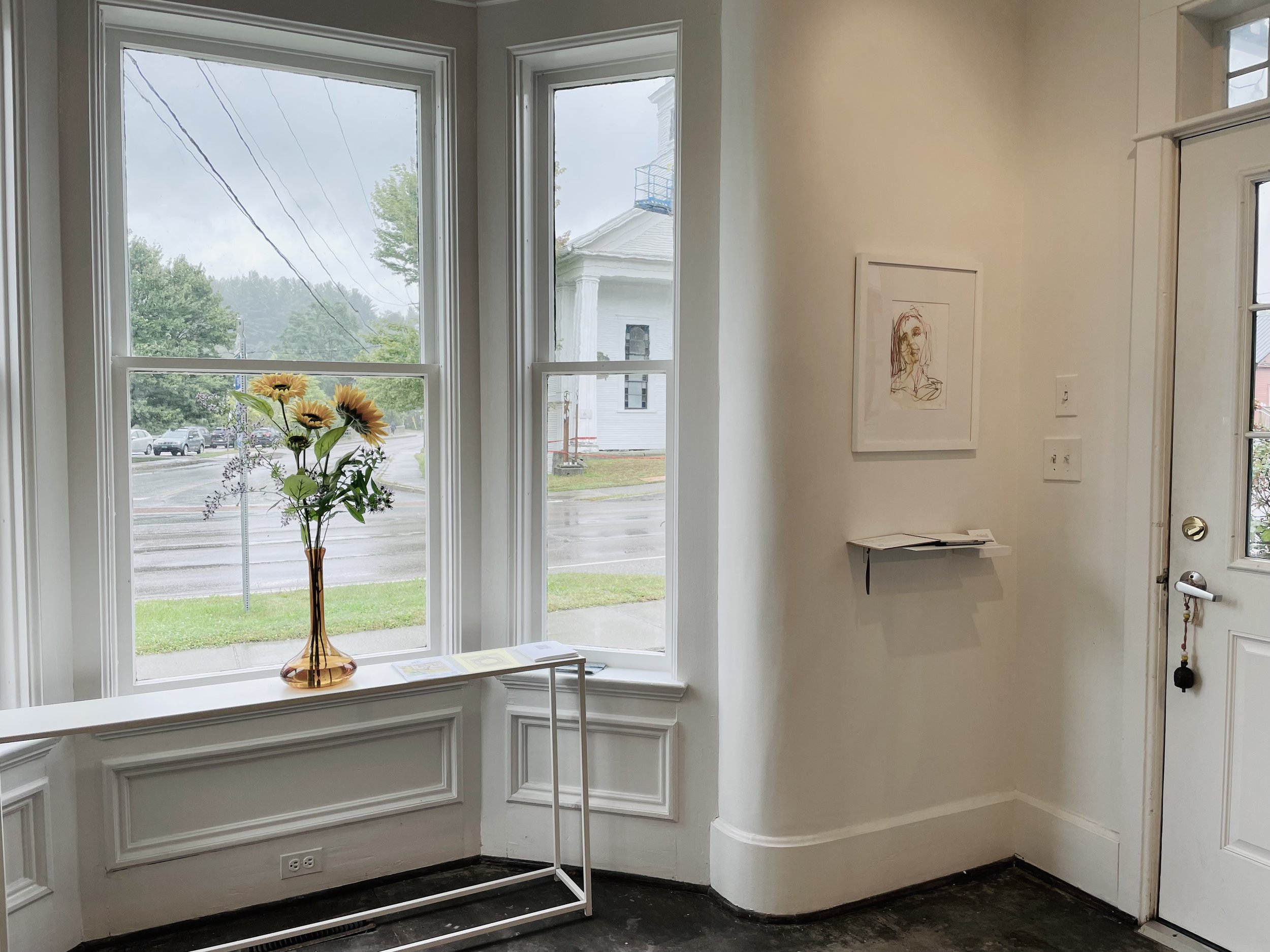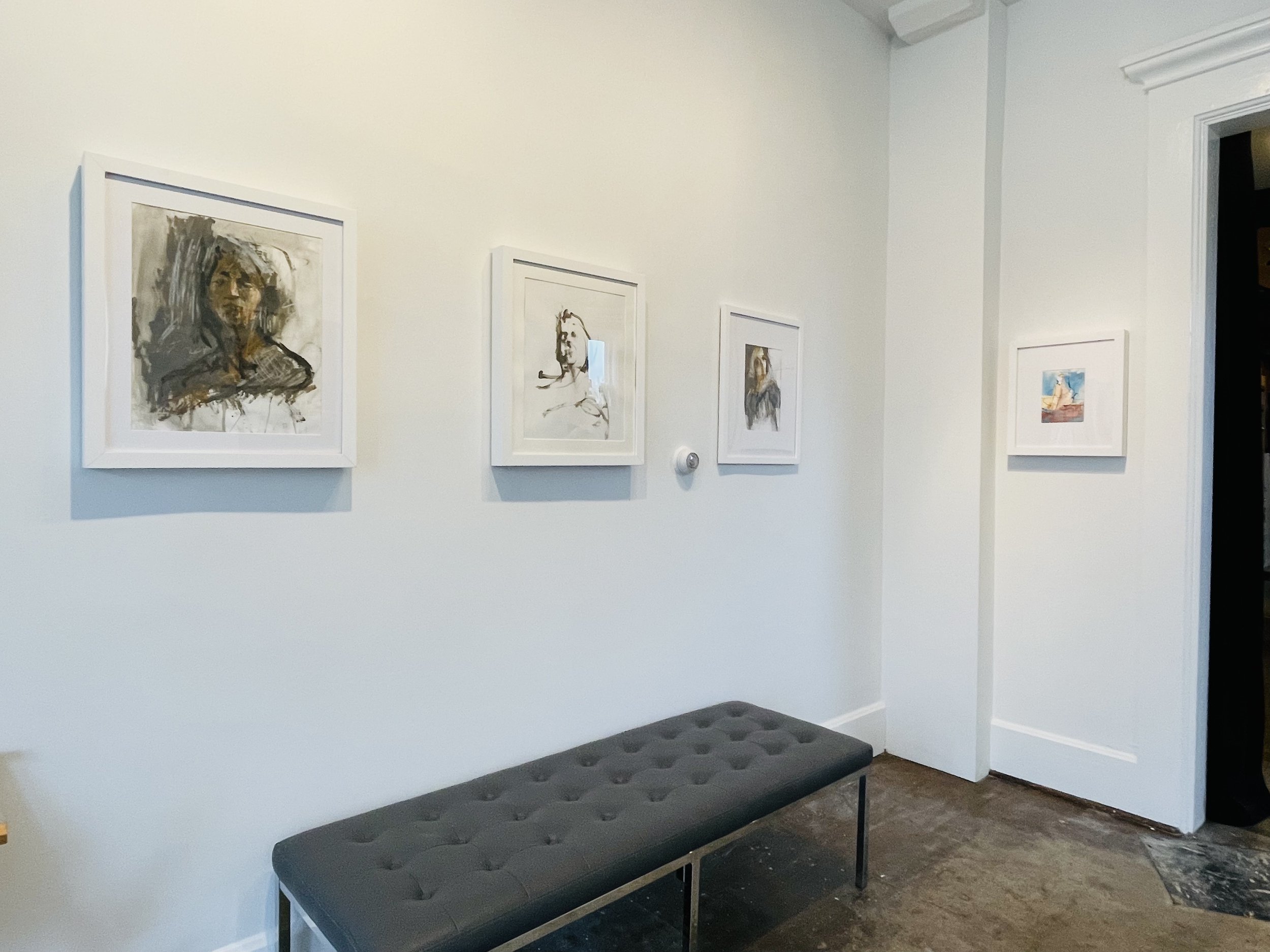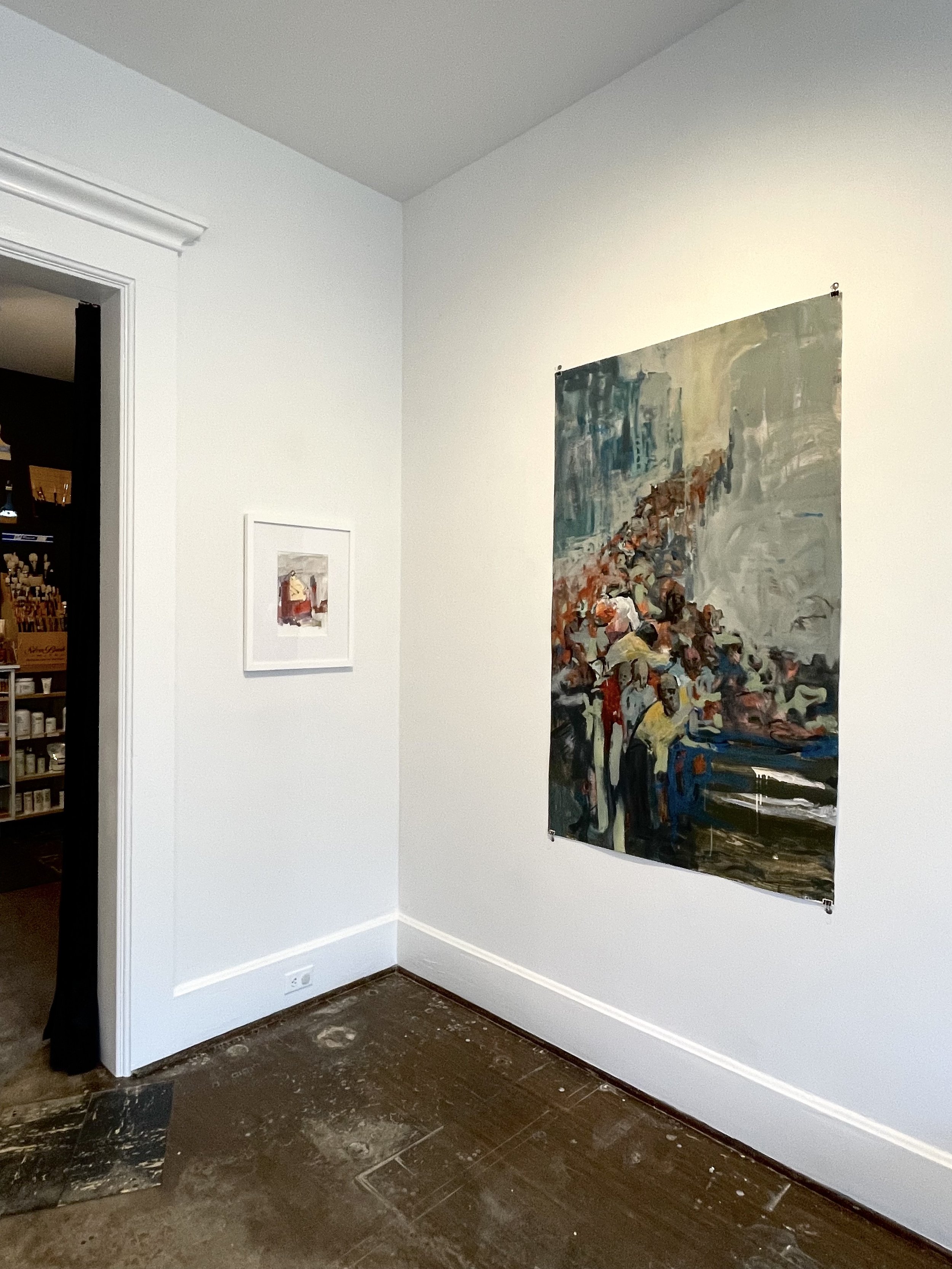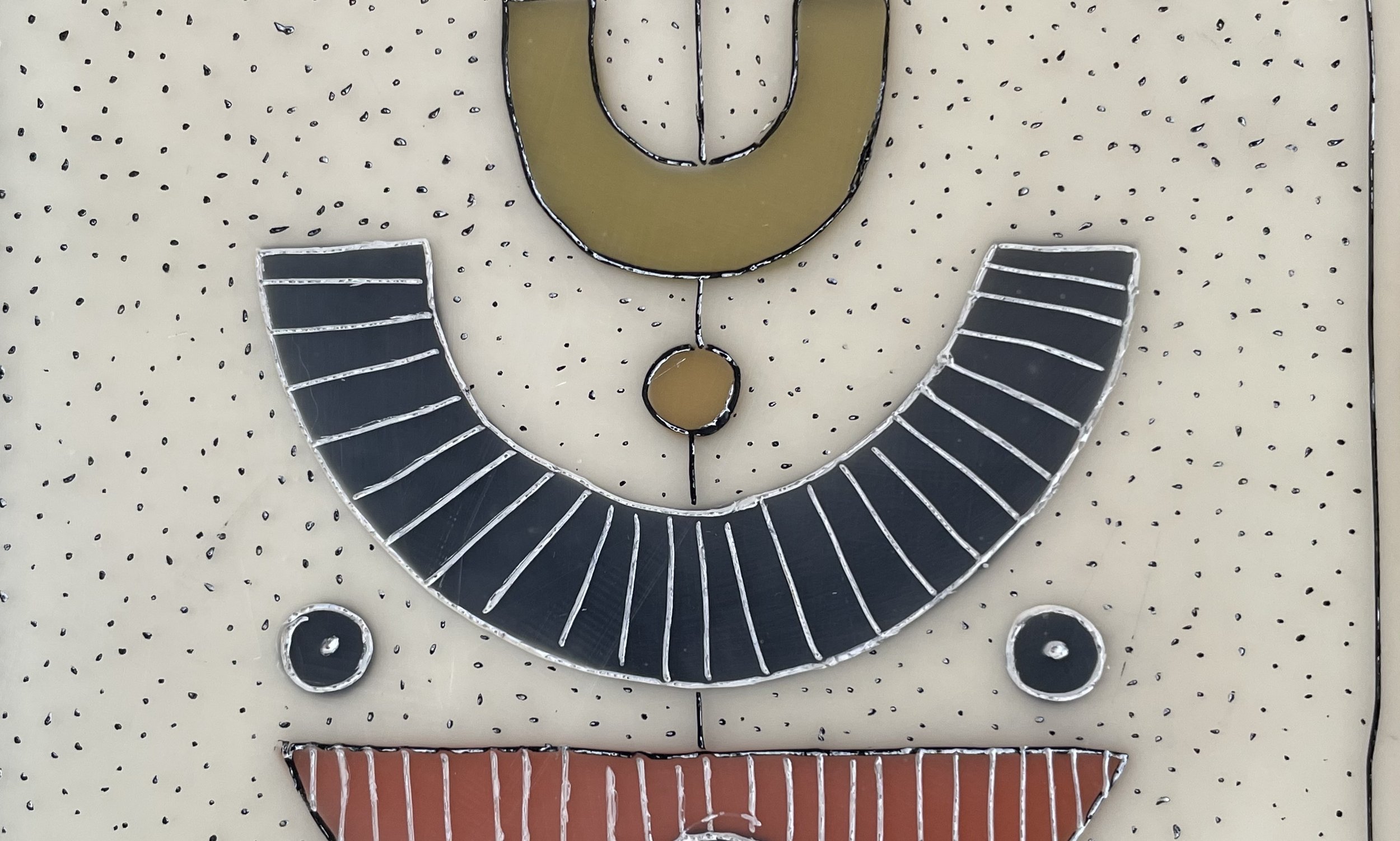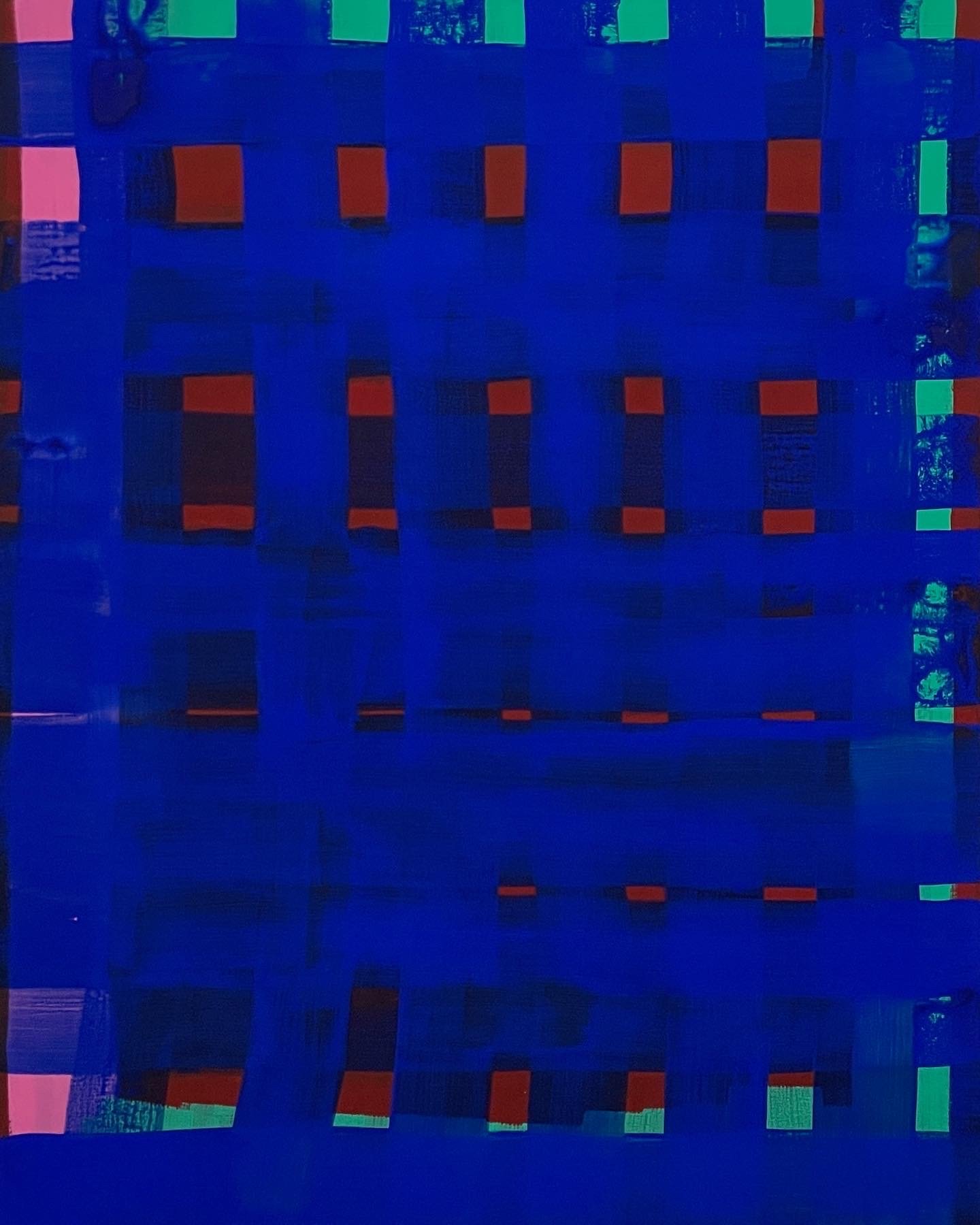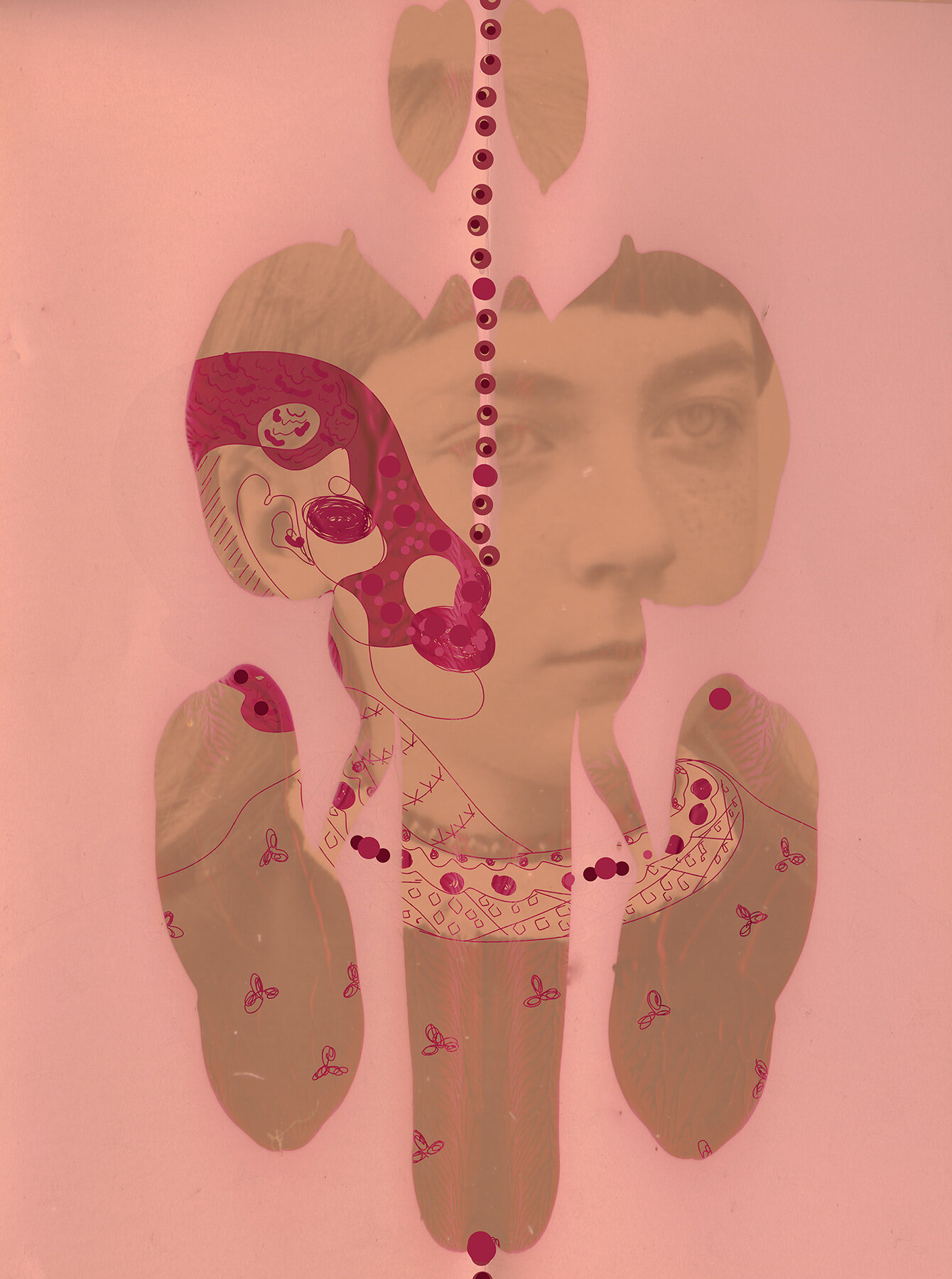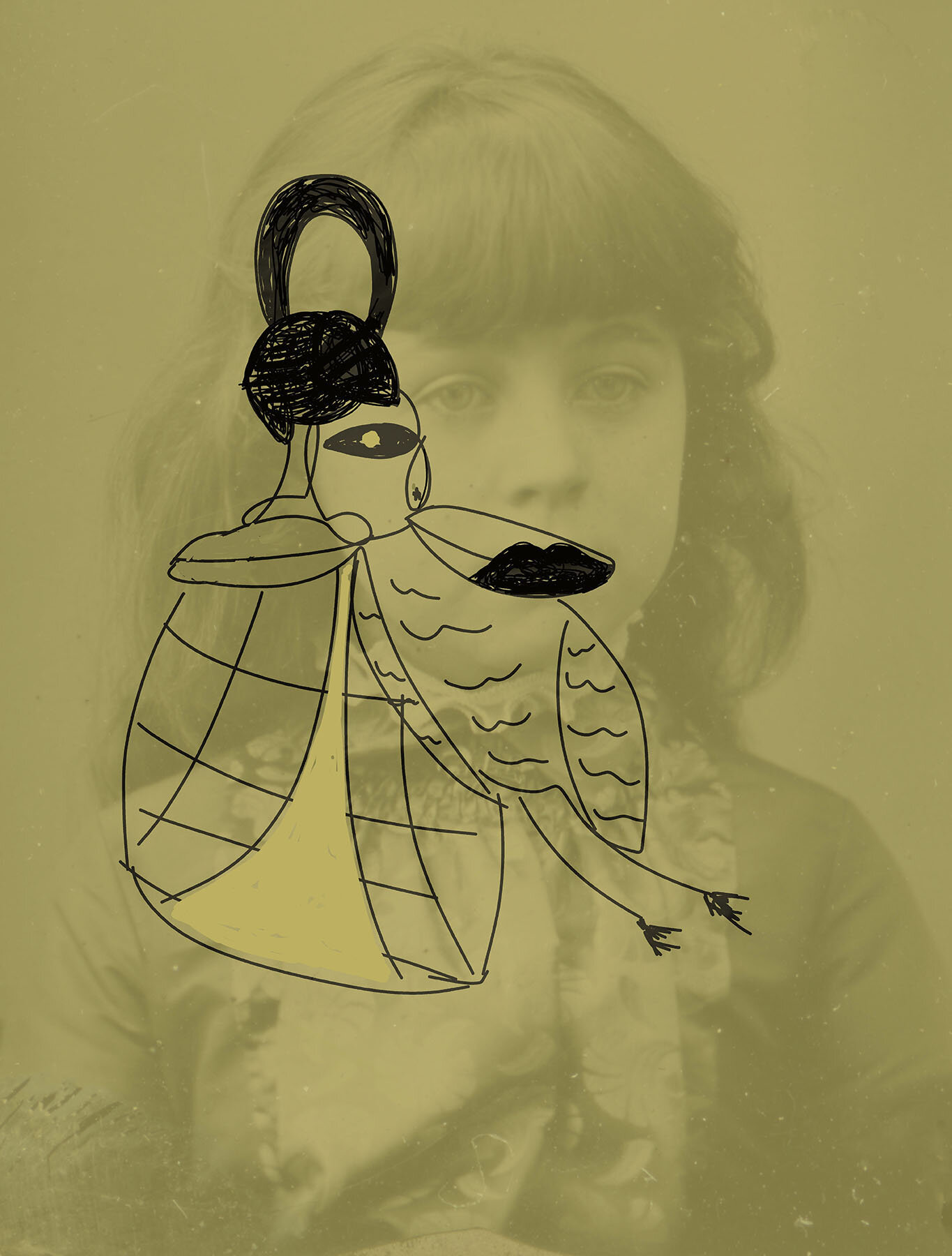Andrea Pearlman
On view through September 2025
Andrea Pearlman is originally from Hartford, CT, but has lived in Vermont since the mid-70’s. After graduating from Pratt Institute in 1974, she and her husband George, headed to Vermont for the quality of life and to be close to their mentors, James Gahagan and Pat deGogorza, artists living in Woodbury. Under the tutorship of James Gahagan, a student of Hans Hofmann, she explored the inherent dynamic push and pull of nature, and the means to express this experience in painting. Using charcoal and drawing from the model, she uses overlapping planes to suggest two and three dimensional rhythms, attempting to capture the essence of the pose. Depending where you look in a drawing or a painting, different things activate. Andrea primarily paints in oil on canvas, but also hooks rugs, using wool strips when “painting” in fiber. The paintings, the drawings and the rugs, all feed each other to express plastic space, a sense of volume and movement.
Moon Dance
Andrea’s work is deeply influenced by James Gahagan. In a 2023 Seven Days interview with Pamela Polston, Pearlman stated, "James Gahagan said 50 years ago, let the color determine the shape," Pearlman continued. "It's kind of random in the beginning: You put down the color; you react; you move it around. Nothing is really preconceived. So it's always an adventure."
Past Exhibitions
Valerie Wilcox
Embracing ALl The good parts
On view through June 2025
Hope, second chances and authenticity are the values that Wilcox strives to incorporate into her artistic practice. The intent of her work is to provide a sense of optimism in society’s ability to reinvent itself.
Wilcox takes common materials, consumables, and the flawed and imperfect remnants from our built environment and creates these hybrid works that celebrate the imperfect and unconventional. The process for her is about intuitively exploring contradictions and uneasy associations between abstract shapes, textiles, mark-making and painting. With her process-based style of working, she problem-solves each piece not unlike a puzzle. She encourages the odd combinations, quirky shapes and color explorations to materialize and create the unexpected.
Architecture and design are important structural influences in Wilcox’s work, while the movement and life force of the body provides an organic counterpoint. The work often references the body moving amongst our built environment as we constantly maneuver around these structures, both physically and psychologically we’re constantly adapting and modifying to a new framework, system or barrier.
These assembled hybrid objects become her canvas and manage to transcend their base materiality, as the source materials are elevated and imbued with a newness of form and aesthetic.
Joy Ray
ChromoTOPIA
On view through January 2025
Joy Ray’s interdisciplinary practice explores textiles as instruments of divination, adopting techniques like quilting and weaving to conduct inquiries into the spectral, speculative, and unreliable. Central to Ray’s research into the unknowable are methods of abstraction, concealment, illumination, and reconstitution that extract visual language from source materials like archival texts and oral histories.
Katherine Clarke Langlands
Romance
Acrylic, driftwood 2023
On view through November 2024
THE BEAVER DOES NOT USE DEAD TREES
The driftwood used in my DRIFT works is often sourced from Block Island, an island 13 miles off the coast of Rhode Island. A rock in the middle of the Atlantic Ocean, Block Island, has few trees — most of which were likely introduced by humans. To make it to the island’s beaches, the wood drifts from surrounding richly forested areas like Northern Vermont, where I spend most of the year.
In Vermont, the dialogue between humans and our animal counterparts is at times territorial. To prevent native beaver populations from gnawing on our prized maple trees, some neighborhoods install metal fixtures near their base. It turns out the beavers have no use for dead trees.
Each of these pieces was once a tree, but now they’re dead wood. After drying and treating the wood, I bring them to my studio in Vermont to revitalize them. In my view, the wood isn’t wood — it’s a structure, and one that can accept paint. The question is how to paint that structure so that it becomes more tree than wood, making it vital again. The alchemical powers of color play a large role in that transformation.
Their next transformation occurs in the exhibition space, where they poke and prod at a number of conventions related to painting and its traditions.
Humans are silly; they use dead wood.
Athena Petra Tasiopoulos
ARTIFACTS
A collection of recent encaustic collage works
June 18th-September 7th, 2024
Opening Reception: June 30th, 2-3pm
I’m interested in our mental and emotional blueprints. The push and pull of interconnectedness. The delicate nature of equilibrium.
I work with recycled and found vintage papers encased beneath a layer of encaustic (beeswax). I gravitate toward soft, muted colors — warmed and stained by time.
Repetitive patterns and primitive marks carved and scraped into the surface of the wax speak to the imperfections of the human hand and the vulnerability of materiality.
Quiet World
Quite World (detail)
I see my practice as a meditation on transience, transformation, and the beauty of imperfection. An embrace of what is — as it is.
Julie A. Davis
Painting The Town: Iconic Landmarks of Johnson, Vermont
March 12th - June 8th
Artist Talk in partnership with the Johnson Historical Society, June 2nd at 2pm.
Julie A. Davis presents expressive oil paintings from her private collection depicting iconic images in and near the town of Johnson, Vermont. Johnson is home to a suite of beloved architecture, nestled against the Gihon River and home to the Vermont Studio Center artist retreat. A portion of artist proceeds will benefit the Johnson Flood Recovery.
This collection was recovered from an archive of work I had completed over the course of a decade at a time when I lived and worked out of the environs of the Vermont Studio Center. During this time, I became very attached to the town of Johnson and what I see as architectural figures.
Some paintings were created from life or on-site, and others from memory or imagination. I work from intuition, often with little thought as to the outcome. I seek to venture towards the abstract and yet also carry a narrative.
Some paintings are pure oil and completed plein air, such as The Lamoille. Others combine oil and acrylic (The Bridge, The White Church). The Grey Village was completed on Gould Hill—for me, a coveted bird’s eye view.
Torry’s large painting is of her garden, a two-acre lot in the Northeast Kingdom. Her painting filled with bright flowers carefully nurtured by Torry transports me back to summer days in her garden. Furthermore, a lot of the flowers in Caroline’s lumens are from Torry’s garden. Torry’s painting and Caroline’s lumens are odes to the very same flowers in the same small corner of Northeastern Vermont.
In the difficult summer of 2023 Torry’s garden was flooded. Now, post-flood when the garden is covered in mulch and snow, these paintings and lumens become an invocation for the plants and animals to return, despite the destruction of the flood. Now in the winter, there is uncertainty of not knowing what of the flooded flowers will rise again in the spring. Torry’s painting is a hope for future gardens after the floods of 2023.
Victoria Zolnoski (teacher) | Caroline Loftus (student) | Mary Martin (critic)
Teacher Student Critic
December 19th - March 9th 2024
Reception: Sunday, January 14th, 2-3pm
When first thinking about the art of Torry Zolnoski and Caroline Loftus, I am struck by their worship of nature. Both Caroline and Torry have a need (it is not a want) to be outside in nature When I hear them speak with each other I am not sure if they are two artists, two gardeners or two botanists. In truth, they are all three.
Caroline and Torry have a deep reverence for flora and fauna; whether it is Torry’s memorial to the rabbit or Caroline’s ode to flowers, they are all a reverence for life and for our Mother Earth. They honor nature's power. Their artworks are aide de memoires so that we can remember each individual plant and animal with careful reverence.
The process of lumens is it is not a quick process. It forces Caroline and Torry to slow down, to pause. They wait for Mother Nature to do her work as part of making the lumens. In our age of rushing about smartly and not necessarily accomplishing much; this process forces the artist to slow down and create these great odes to nature’s creativity. They honor that which is untamed and beautiful. In the wilderness Caroline and Torry find the ultimate source creativity.
Both Caroline and Torry are knowledgeable with photography with cameras; but by doing lumens, they are choosing camera-less photography. Camera means room or chamber and when they do a lumen, they are doing a camera less, room-less photograph. The camera is now nature which cannot be controlled like a Nikon or Pentax camera with meters and f stops. With lumens, nature is not just a subject matter but one of the artists. Caroline, Torry and Mother Nature made the lumens.
When I view this exhibition, I see flowers dancing on the lumens. I honor the life of the rabbit from the northeast Kingdom. I imagine conversations with the flowers as a part of a daily walking meditation through the flowers. I see proud colorful portraits of flowers that have withstood the bracing raw weather of Northern Vermont. This exhibition reminds me of the plants of summer in the middle of winter is a way that acknowledges my hope for the future flowers and lazy, warm summer days.
Jo Weiss
Absence/Presence
September 19th - December 2nd
Gallery Reception: October 15th, 2-3pm.
To me the choice of working with representation is akin to the choreography of stage or dance. In drawing and painting, I exploit what I can from the object or figure’s gesture into something redolent of impending action.
I try to use the materiality of media as a vehicle with which to explore the duality between space and surface.
The figures are the means through which I develop a sense of fluidity and volume that energize the pictorial space.
Light from a window captures the silent ebb and flow of dust in an otherwise empty room, stirred only when the air is disturbed by the presence of energy.
TINY FIREWORKS
July 4th- September 16th 2023
Athena Petra Tasiopoulos, Andrea Pearlman, Abigail Synnestvedt, Marjorie Kramer, Tamara Malkin Stuart, Lynne Reed, Louise Von Weise, Annie Pearlman, Kathy Stark, Marie Lepré Grabopn, Lois Eby, Wiley Garcia, Mollie Douthit, and Arista Alanis
Closing Reception, September 10th, 2-3pm
We invited 14 Vermont-based and Vermont-affiliated artists to submit two of their smaller works (no larger than 12x12”) for one salon-style group show.
The show’s title, Tiny Fireworks, is borrowed from a passage in Mary Oliver’s poem Hummingbirds:
The female, and two chicks,
each no bigger than my thumb,
scattered,
shimmering
in their pale-green dresses;
then they rose, tiny fireworks,
into the leaves
and hovered;
then they sat down,
each one with dainty, charcoal feet –
each one on a slender branch –
and looked at me.
I had meant no harm,
I had simply
climbed the tree
for something to do
on a summer day,
not knowing they were there,
ready to burst the ledges
of their mossy nest
and to fly, for the first time,
in their sea-green helmets,
with brisk, metallic tails –
each tulled wing,
with every dollop of flight,
drawing a perfect wheel
across the air.
Then, with a series of jerks,
they paused in front of me
and, dark-eyed, stared –
as though I were a flower –
and then,
like three tosses of silvery water,
they were gone.
Alone,
in the crown of the tree,
I went to China,
I went to Prague;
I died, and was born in the spring;
I found you, and loved you, again.
Later the darkness fell
and the solid moon
like a white pond rose.
But I wasn’t in any hurry.
Likely I visted all
the shimmering, heart-stabbing
questions without answers
before I climbed down.
***
Mary Oliver
White Pine (1994)
Tiny Fireworks brings together small-sized paintings/works on paper in the styles of abstraction, geometric and narrative painting. The salon-style presentation is informed by the variety of painting styles and their poetic connections.
Detail of painting by artist Tamara Malkin Stewart
Detail of print by artist Wylie Garcia
Detail of painting by Andrea Pearlman
Detail of drawing by artist Annie Pearlman
Detail of painting by artist Louise Von Weiss
Detail of “Rising” by artist Athena Petra Tasiopoulos
Pamela Wilson
Potentiality
May 9th - July 1st, 2023
Opening Reception & Artist Talk, May 21st, 2-3pm.
What is the material of nature and what is the nature of material?
What does it look like to work within the limitations of what’s immediately around you and with the propensities of the natural world?
What else can a plant or a substance be?
What have we missed?
What does the material need from us?
What are the invisible currents or connections that can act as creative “high voltage wires” when we accidentally bump into them?
These are some of the questions animating my making since my last show at Minema. For this second show, I spent time looking at the materials and material processes I use. While I work in several mediums, I see a set of skills and techniques that weren't historically siloed away from each other. The making of thread, cloth, pots, baskets and adornment with color are parts of the human survival experience. I’m curious how seeking utility, delight and awe within one’s immediate landscape remains, even as we reckon with how our human decision-making and actions/inactions have irrevocably changed that landscape and the wellbeing of its human and non-human inhabitants.
Throughout the gallery, you’ll see iterations of charcoal, indigo, black walnut, wild grape, ochre, ash, pits, seeds, wool, vine, flax–materials with long art-making histories. Water was also a collaborator–sometimes generous, sometimes fussy and maddening, in both the processes on the workbench and the wider geography. Potash Brook runs (culverted) immediately below my studio in Barre–a building and town whose economic vitality has been tied to the rivers, the rock and the ability to move these resources or (floods are common,) be moved by them.
For the last year, I've been collaborating with Dr. Harlan Morehouse, a social geographer. We've been thought-partners around the topic of the ecologies of art-making--the relationship between landscape, maker and materiality. The Mushroom At the End of the World, Rebecca Solnit’s Orwell's Roses, Bernard Heinrich's The Winter World and Barry Lopez's Arctic Dreams and Embrace Fearlessly the Burning World are some of the texts in my ear during this last year in studio. All consider developing deep and sustained relationships with a landscape and multiple methods of attunement and regard for a particular place, animal or material. They consider landscape-dependent art making-materials, mutually-beneficial/mutually-caretaking relationships between humans and the natural world and holding multiple awareness of timelines beyond the human lifespan.
What’s growing along the desire lines of environmental collapse and how can that lead the work?
These were the materials explorations I leaned into during these last two not-over-yet pandemic years. The questions I asked of the materials were also the questions that scaled as my post-lockdown engagement with the wider world evolved. What do we have and how has it changed? How does it want to move despite our attempts to intervene? How does it consent to transformation and how does it subtly (or aggressively) resist attempts to transform?
"The seductive simplifications of industrial production threaten to render us blind to monstrosity in all its forms by covering over both lively and destructive connections. They bury once-vibrant rivers under urban concrete and obscure increasing inequalities beneath discourses of freedom and personal responsibility. Somehow, in the midst of the ruins, we must maintain enough curiosity to notice the strange and wonderful as well as the terrible and terrifying. Natural history and ethnographic attentiveness--themselves products of modern projects--offer starting points for such curiosity, along with vernacular and indigenous knowledge practices. Such curiosity also means working against singular notions of modernity. How can we repurpose the tools of modernity against the terrors of Progress to make visible the other worlds it has ignored and damaged? Living in a time of planetary catastrophe thus begins with a practice at one humble and difficult: noticing the worlds around us."
FromArts of Living on a Damaged Planet by Anna Tsing. Page M7, University of Minnesota Press, 2017.
Patty Hudak
Gyring, Spiring
March 11th - May 6th
Artist Talk & Poetry Reading:Sunday,April 30th, 2-3pm
My artwork delves into the solitude of the natural world, offering a respite from the chaos of modern society. When I venture into the woods behind my home, the trees, plants, and microbial systems reveal themselves to me as otherworldly patterns of shapes and colors.
My paintings are an expression of the emotions that nature evokes within me, akin to the sentiments found in the poetry of WB Yeats. As a person of Irish descent, I am drawn to Yeats' association of nature with spirituality. My mother's hometown in Ireland is steeped in over 5,000 years of history and a culture that was deeply intertwined with both the natural and supernatural realms. A well-preserved stone circle near where she grew up remains intact despite centuries of invasion, occupation, and modernization. These ancient ceremonial grounds still maintain a mystical connection to the surrounding landscape, as they have for thousands of years.
Like Yeats, my work emerges from a set of daily practices, including daily drawing when I wake up, guided by my empty mind. This exploration seeks to find a visual representation of my mind, a connection to the supernatural, and the ancient wisdom of our ancestors. The forms that emerge from my drawings are the twisting shapes that Yeats describes as the form of the mind - gyring, spiring, subtle twisting forms.
These forms are echoed in the natural world around me, particularly during turbulent weather, as referenced in Yeats' poem "The Two Trees." The opening line, "Beloved, gaze into your heart, the holy tree is growing there," suggests a link between our inner selves and the branching trees. Yeats' tender words convey the wordless emotions I feel when connecting with the supernatural aspect of nature. I experience a sense of unity with the natural world and a presence larger than myself. The second stanza reveals a darker side, where "a fatal image grows."
Poetry and painting provide powerful mediums for exploring complex, subconscious concepts like love and mortality, as symbolized by the two trees - one brimming with potential, the other fraught with apprehension. These images resonate with our surroundings in Vermont, where spring brings new hope and opportunity, but also violent weather patterns caused by climate change.
Every walk through the forest exposes the duality of these worlds, which has become a point of contemplation for me while creating my artwork. I lose myself in layers of paint, allowing my emotions and visions to flow freely as the colors choose themselves. This creative process requires my utmost focus while simultaneously freeing my mind from judgment.
Meg McDevitt
Iterations
January 17th - March 11th
Artist Talk: Sunday, February 19th, 11-Noon
The works in this show offer a variety of approaches made with a sculptor’s sensibility, applied through acts of drawing.
The large-scale ink drawings combine the spontaneity and deliberation inherent to working with ink.
An ongoing series of ink-colored pencil drawings and collages inspired a selection of embroidered works and another way of exploring working with shape and line.
My new series of small drawings are made with black hot glue and explore the use of a material that is used when heated and flowing.
Sculpture allows a way to bring drawing into three-dimensional space and I have included some paper mache and sculpted linear materials that are combined and installed in response gallery space.
Although there may not be obvious similarities between the different works in this show, they are linked by tenets of drawing and the desire to create unexpected variation. It is my hope that viewers will engage with the physicality of my work and my imagination.
I became interested in embroidering as extension of my drawing process and because I needed an activity that would keep me busy when I was at home in the evenings in the winter months. I have always been curious about textile arts but had never found a way to include it in the sculpture or drawing processes in my studio practice. I also wanted a way to translate the drawings that I was doing into a slower, more contemplative activity.
I turned the embroidered drawings into small pillows but are meant to be held and appreciated by holding them in one’s hand. The surface, line and shapes that happen in drawing are revisited with slow methodical stitches.
It was important that the entire surface of each piece be embroidered. The pillows take approximately 30 to 40 hours to create.
I love materials that transition from wet to dry, hot to cold, liquid to solid. I am happiest when I can discover ways to combine sculpture and drawing into one activity.
I have experience in established ways of bronze casting and plaster mold making, but I wanted a more immediate way of realizing works that used the properties inherent in these mediums. I wondered how to include drawing. I began working with pouring to create shapes and line. I poured wax into snow. I poured plaster onto the floor or onto Plexiglas sheets on the table surfaces in my studio. Recently I discovered that I could draw with hot glue. I found black hot glue sticks. I made drawings on silicone mats and on paper. I pressed the drawings while they were cooling under boards to flatten the glue.
The size of these drawings is based on the time it takes for the hot glue to cool. I wanted the drawings to be spontaneous, so they had to happen quickly. I would prepare paper and make as many drawings as possible in one session.
The paper curves slightly when the glue cools. I see these drawings as objects, so I would lean them on my bookshelves in my home. Each hot glue drawing has been redrawn as line drawings in graphite. Again, this is a way of revisiting and working with iteration.
I began with the idea of filtering inks through different kinds of papers and materials as a way of understanding the properties of ink as a fluid medium.
I used rice papers and tracing and crepe papers. I impeded the filtration and absorbtion and drying times of the inks with plastic wraps and foils. Most of these materials come in rolls. Many of these materials come in 20 inch rolls. Others I cut down so that the size of the rolls would be consistent. Once dry, I would hang the drawings in my studio and revisit them with brush and line-work, another way of working with ink.
I wanted to include shape and so I began filling in blank areas in the drawings. These shapes had a sense of character and engagement with the plasticity of the visual surfaces. I wanted to make these drawings large enough to make the viewer feel immersed when standing in front of them. However, I still wanted them to be realized as drawn objects.
Marya Lowe
SCATTERED COHESION
November 12th - January 14th
Artist Talk: Sunday,January 8th, 11-12pm. Free. No preregistration required. Muffins and tea will be served. All are welcome!
Color, visual texture, and energy are all bywords for the abstract work that I do. It began as a self-challenge to make 100 small improvisational blocks in 100 days. Starting out, there was no plan for how to use these “wonkies”, as I began to call them. Nor was there a sense of what they would teach me. But when more than 100 wonkies were piled on my table, I realized that I had learned how color energizes me, how too many colors clumped together can create discord, how the use of black-and-white always gives punch to a square of colors, and how certain shapes lend themselves to design interest.
That knowledge encouraged me to group certain of the wonkies into compositions, grounding them with a calm background, and that combination has become a major part of my voice.
In time, I learned that multiple wonkies could be melded into one large piece of “made-fabric”, toned down and encouraged to merge together by doing a color wash over the expanse of abstraction. From that point, I was only a circular rotary cutter away from what I called “upscale wonkies”: circles carved from one of these made-fabric pieces. But always, the energy was harnassed by a calming background. “Control the chaos” became my own personal mantra.
The majority of my work is fused and then heavily quilted to ensure the piece’s stability. Commercially printed fabric (how lucky we are to have such wonderful designers providing us with these fabrics), my own hand-dyed fabric, vintage fabric, beautiful threads and other embellishments all provide means of expressing the energy, the calm, the chaos, and the control.
Aqua, 2014
Lilac-Breasted Roller, 2018
Old Barn Door, 2015
Minėmå Art Collective
ongoing exhibition
We’re excited to introduce the Minėmå Art Collective- an exhibition featuring the unique works of our past showing artists as well as a few new!
This Collective has been culled and curated to inspire and bring affordable fine contemporary art & craft to your home & worlds..
Every week we will be adding new pieces to this rotating exhibition of fine contemporary art & craft by a dozen or more Vermont-based women artists.
Patty Hudak
Currently showing are the unique works of fiber artist Rose Pearlman, photographer Cathy Cone, multimedia artist Patty Hudak. ceramicist Pamela Wilson, poet Clara Diesen, painter Andrea Pearlman, sculptor Katherine Clarke Langlands, painter and jeweler Jean Cherouny, quilter Marya Lowe and painter/sonic artist Renée Lauzon.
Renée Lauzon
The Break Up
May 10 - June 18
My working process uses sonic and visual language to explore sensory perception, emotion, memory, and the affective force of sound.
In the visual works, sonic information is translated into color and surface through deep and repeated listening. During a painting session, I may listen to a single song multiple times in order to immerse myself in the sonic space until it becomes muscle memory.
By inhabiting sound and integrating it with my body, I am able to reproduce a visual record of felt experience. Sounds drive the brushwork and informs the duration and pressure of each mark. A limited palette applied as a conceptual frame confines decision making while allowing for intuitive expression, failure, and uncertainty.
The sounds that arise in liminal spaces of attack and decay refocus our attention on sensory perception and its messages we often miss out on in our daily lives. At its core, listening is an act of love and an acknowledgement of the interdependency and intersubjectivity of being.
Together, paintings and sound works call and respond to each other in an interwoven aural and visual experience.
In the sonic works, I use digital instruments, field recordings, and spoken word to create expansive sound landscapes that envelope the listener. In this process I’m concerned with the birth and death of a single note, and the subtle and introspective activity of listening.
Katherine Clarke Langlands
Visual Rhythms
March 8 - May 7
Art is a way to access something that is non- verbal within ourselves and using color, shape and abstraction is especially a way I do this.
Abstraction is something that you can not define. My current work is rooted in this observation.
Visual Rhythms are made with recycled vinyl records that are usually scratched and beyond repair of the intended use. I collect, paint, heat, cut, sand, wash, heat again and then mold the vinyl. I began using this material to make a birthday present for my Grandma. That birthday present turned into years of making wearable abstract paintings that can be worn as bracelets.
I can’t help but think of the number of hands that have been involved and the lives that have been affected in the making and listening of, a record. Visual Rhythms are a reimagined, revamped design of an already beloved yet partially obsolete object. During my process an organic theme of past, present and future is unfolding. I’m making new work from old work and creating something entirely new.
Recently my work with this material has shifted and evolved and the outcome of this development has turned into the creation of true abstract sculptures and sculptural paintings, each piece being one of a kind and totally unique. Like so many of my paintings, this work is absolutely about color and shape and also about the re-use of materials, inventiveness and the cycle of art.
The drift sculptures (referred to as ‘Drifts’) blur the lines between painting and sculpture. I think they relate to the Visual Rhythms, in that they are found objects. Drift wood in its natural form is already a work of art before they come into my studio. Like the Visual Rhythms, there is a theme of past present and future unfolding.So much of my art is informed by nature.Shaped by life.
I use two colors to make the line paintings and they're meditative to make, and they resemble the back of a record the lines on the back of a record.My color palette changes a little bit depending on my geographical location at the time. The shapes found in nature, the trees in the mountains, have had a strong influence on my work, especially my current work.
Rose Pearlman
Counter-Space
January 11-March 5
Counter: demoting movement or effect in the opposite direction.
Space: an area that is free or unoccupied.
Counter-Space: the physical space of tabletops and surfaces and the objects they contain.
Punch needle rug hooking, consisting of hundreds to thousands of densely packed loops, traditionally results in durable, functional objects. Created with a handheld rug hook or punch needle, small stitches of fiber are created slowly and methodically. While the imagery depicted in rugs is a matter of artistic expression, the construction of items meant for practical everyday use involves specific technical guidelines and materials.
The wall hangings move away from utility and become ornamental, as I explore the fragility of a single hooked line, and find the balance between negative and positive space. While my rugs no longer serve a functional purpose, the technique is still deeply rooted in the knowledge and skill of this medium’s rich history.
Rug hooking roots are linked to a tradition of resourcefulness for domestic life that dates back to the early 19th century of the New England coast and Maritime Canada. This craft has been lovingly preserved and improved upon, thanks to generations of women and men who have adapted tools, restored rugs, and passed down the teaching and practices of those who came before them.
With this exhibit “Counter-Space”, I explore a modern approach to making rugs, letting go of the restrictions and rules that come with making useful objects.
In creating my hooked wall hangings, I used rug wool and uncommon materials such as deconstructed plastic bags and butcher’s twine. These materials pay homage to rug hooking resourceful roots and sustaining practices where repurposed clothing and burlap grain sacks were once used. In my reinterpretation of "domestic spaces,” I use the double-entendre “counter-space” to depict an abstracted still-life scene of everyday clutter on tabletops and surfaces. By removing color and flattening dimensional planes, I have stripped away the disorderly household mess and replaced it with a simplified version that focuses on the contrasting positive and negative spaces and the reductive organic and geometric shapes that are inherent within.
Cathy Cone
There Was Once…
November 2- January 8
Hand Painted Photographs
My grandmother raised me. She was born with a large birthmark in the shape of a fish that covered her chin and neck. She referred to it as her purple stain. When I was young she would often tell me the story of how it happened repeatedly throughout my childhood. She told me her mother cut her finger cleaning fish when she was pregnant with her. Her mother put her finger up to her mouth immediately to stop the bleeding and according to my grandmother,“marked her”.
Her mother died as a result of my grandmother’s birth several weeks later. Had she explained it any other way I would be a very different person today. I saw a beautiful pattern imbued with magic not an imperfection. My grandmother suffered through stares and pointing fingers often as I was holding her hand. These kinds of folk stories and explanations were part of my childhood and nurtured my imagination. They held a transformative power as a kind of magical soul medicine.
The composition is essentially a duet where both mediums are of equal importance. I’m interested in the translation of these found tintypes by reanimating or resuscitating the portrait. I think of the portraits as time travelers while painting late night seances. With the help of technology, the scanned tintypes often lead to new clues perceptually. It provides a field for painting and mark making. Perhaps they’re tarot cards from outer space. It’s my way of re-touching history.
I begin by scanning tintypes that I started collecting in the late seventies. The printed photograph then becomes a contemplative ground for painting. They are independent of each other physically, historically and on many other levels. The painted photograph essentially is a duet in which two mediums may contribute towards a whole. The integrity of both exists simultaneously in a shared physicality through and on the photographic print.
“There Was Once”
I began by contemplating the temporary nature of things in choosing a title for this exhibition.
The images are layered histories of memories reassembled from a completely intuitive place.
I’m looking at my inner story as to connect and transform. I’m interested in the inquiry of how different mediums converge in a translation of the work.
I try to let the work guide me through an infinite loop of constructing and deconstructing. In a nutshell, it's a transformation station.
I like personal stories and this is mine.
Several years ago the farm up the road that had several horses. I had
practice of walking there each day and making images of an old horse that wasn’t long for this world. One day the owner came out and and ask why I was spending so much
time photographing her ugliest horse when she had these other gorgeous mares. I answered, “because this one is magic.”
Marya Lowe
Vibrantsee/d
August 31- October 30
As a fiber artist, I am entranced by both pure, calm abstraction, and the exuberant celebration of everyday objects. In the case of abstraction, my goal is to provide for my viewers what I myself have experienced when arrested by a particularly special piece of art: an “ahaa” moment, the compulsion to stop and really dwell on what the work says to him, the gift to be fully “in the moment”. When everyday objects draw me to the reality end of the spectrum, I create fiber pieces that are light-hearted and whimsical.
Commercially printed cottons, hand-dyed fabrics, second-hand clothing, silks, and vintage fabrics comprise my fabric palette. I create fiber works by the traditional quilting method of machine piecing, and also by cutting and arranging fused fabrics as if painting a canvas with textiles. Handling fabric and manipulating its inherent elements to suggest stillness, or energy, or mystery, or opulence, or sheer fun, is what enlivens my studio practice.
Working in series helps me to develop ideas more deeply, and provides a structure to my studio work. And since single ideas have a way of spawning themselves, there are several series going at one time.I am currently completing the 27th quilt in a series of abstractly shaped seed pods. I have created several “Recipes From Heaven” that celebrate great recipes from people dear to me who have already passed away – more fabric bundles are set aside with recipes and sketches tucked into them for future “Recipes From Heaven”. Birds and birdhouses are another favorite series theme.
Unless I am building a purely representational image that requires careful template piecing, I tend to work improvisationally, dipping into my color-sorted scrap buckets, making works that highlight visually busy areas against areas of supporting calmness.
Teapots are a new theme, with several already completed and others partially done. But my heart and mind really yearn for pure abstraction, letting colors and visual textures play out next to each other in a composition that holds both mystery and tranquility. Taken altogether, my art celebrates both the energy of the particular and the calmness of abstraction.
Botanical Ornament 5
Lightness of Being
Patty Hudak | Tuyen My Nguyen
Chiara No | Tara Thacker
June 29th - August 28th, 2021
The Pandemic brought humans into deep, mental spaces- sometimes shadow, sometimes light. Emergence from the collective trauma of the events, have brought about shifts in expectations, imaginations, and realities that we can no longer tolerate, as well as feelings of humility and powerlessness.
I turned to nature for answers to existential questions which I had not considered in decades. What I had once experienced as loneliness in nature was transforming into a form of expansive solitude. Was it real or imagined that I sensed a form of energy emitting from the plants and the trees in the woodlands that surround my home? How do I receive these messages?
Initially, I responded by painting the forms of trees, with memories of empirical sensations, such as the touch of my hand on the bark, the smell of the leaves, and the sounds of the birds and chipmunks.
As time passed, and my experience deepened, the supernatural within nature became more vibrant and the reality of my porous body merged with the space between the trees. Our communication networks were melding.
The metaphor of this experience is that of lightness, as I passed through the layers of my shadow mind to enter this translucent atmosphere. My recent work, Botanical Ornaments, is informed by these transcendent experiences, as I seek visual forms to diagram these mystical spaces. Human metamorphosis is possible, as we remember that we are not separate from nature, but part of nature, and that, the plants and animals that surround us are willing to teach us once we are willing to listen.
Botanical Ornament 1
“Breathe” is inspired by the stillness that those fortunate of us were able to experience, at times, during the pandemic. This site-specific installation is a shelter, an abstraction of the organ that allows us to inhale, exhale, and replenish our bodies with the life force that is oxygen, which speeds and slows the blood that pumps through our veins.
Tuyen My Nguyen
Patty Hudak
The coronavirus pandemic, all around the world, upended our lives. Life may never return to normal for some of us after having lost so much. We lost time, experiences. We lost jobs, relationships. We lost people. Despite it all, some of us were afforded the opportunity to slow down, to reexamine the priorities and values most important to our lives and well-being. The speed with which contemporary life swooshes by often leaves us little time to experience the deeply important aspects of our relationships and revel in the quiescent mundaneness of life.
Breathe
Beyond the stress and anxiety that was ever present, I hope we all will remain mindful of this revelation. While we may be swept up again, as swiftly as a tidal wave, in our lives, we must remember that like our breathing, although automatic, we still have the power to manipulate and slow it down, to shelter in place. When we need a moment of stillness to ground ourselves, all we need to do...is breathe.
A circle is drawn around a set of ideas—holes and windows, exits and entrances, calling in and calling out—focusing on the duality of things and their fetishes. I draw on familiar things as if they were my personal daemons, interested in the moment of their transition, when routine becomes ritual, when action and reaction begin to give things objecthood, when a gesture is both defiant and contemptuous, when a refusal to accept is worth making.As the circle becomes conical, my research descends into the body politic of the past’s demons towards today’s Other.
Binding Thread
Nine Licks
in salutem
The heretic, the midwife, the hermit, the foreigner are all historically politicized bodies once considered demons. My critical fabulations are a gateway to dismantling demons within herstory. When we start unraveling this demonology, we start empowering those who are Others—the protester, the marginalized, the disabled person, the neurodiverse—because they are not those; They are us, we are them.
Rectrices (Mourning Dove)
In western histories, daemons once represented the supernatural connection between the human and the divine. As time moved closer to the present, Christianity moved to define, subjugate and eliminate that which is unknown.
If historically witches were feared outsiders and political rivals as suggested by social scientist Silvia Federici, then who, in reality and historical terms, are daemons or demons and how does today’s American culture demonize what it fears?
notum est
Chiara No
The core of my own work is based in sculpture with clay being my primary material not only for it’s for tactile beauty and malleability, but also for the technical and historical challenges that come with it. It is my intention to make works that you don’t immediately associate as being ceramic. The works often appear soft or to be made of fabric rather than the hard fired surface that they are.
I am engaged in a process-oriented approach to art making, bordering on the meditative.
Repetition of form has always been a theme in my work. Each part or element serves as an architectural building block which I combine in various ways to discover how they behave visually. I want even more to make something of it, to transcend its initial existence, and create a new, unforeseen landscape. My current body of work is a series of wall works inspired by birds and the structure of their flight feathers as well as a series of “shadow drawings” which are images of the shadows my sculptures produce.
Shadow Suite #1
Shadow Suite #3
Shadow Study
Shadow Suite #2
Shadow Suite #4
Tara Thacker
This kind of systems-thinking allows for an ethic of care that fits the intimacy of the objects created.
The blanket or shawl that was created to warm or soothe the wearer is part of an iterative process whereby the care of the earth, the sheep, the farmer, the maker and the world it will return to when its useful life is over are held as sacred aspects of the piece.
Jillian Lauren Lisitano
Progressione
February 9th - May 1st, 2021
The legacy of these paintings was birthed centuries before I was - deeply embedded in my dna that can be traced back generations to my sicilian ancestors.
My driving force as a painter comes from a rich and diverse familial and cultural history that is both known and unknown to me.
Memories are sometimes strong, clear, and vibrant, while others are hazy, fluid, and dreamlike.
Every layer, texture and color applied, holds interpretations of this ancestral past that I have collected like souvenirs over the course of my life.
The stages of transformation - from memory to image and image to viewer, is a sacred and intimate conversation I consider vital to my practice.
Pamela Wilson
Primary Focus
May 4th - June 26th, 2021
Grounded in modernist/postminimalist aesthetics and functional design, Pamela utilizes labor-intensive materials and making methods that include the local growing, spinning and dying of fiber and colorants, mixing custom slips and dyes, kiln-building, large-scale communal wood firing and experimental atmospheric high and low-fire surface design.
The materials themselves are elemental and less predictable than other commercially purchased materials or processes—clay, plants, fiber, animal hair, oxides, smoke, melted ash. The surfaces available through these materials are not easily replicable through industrial or commercial means.
By growing, digging, building or mixing many materials from scratch, she is able to maintain an intimate engagement with the natural world, the materials, the body and the nature of the object’s use.
The work of the hand and the action of making is present in each object and each material or tool is carefully chosen with regards to its efficacy and impact. This allows for a holistic, system-based perspective on materials and processes. Identifying the why and at what cost allows for an ethic of care, which is central to the making process.
The backyard dye plant might yield a similar color and add a constellation of less obvious benefits: supporting pollinating insects, protecting a watershed, composting back into the ground after use, preserving a pre-industrial handwork skill, beautifying the built environment and providing an up-close learning and harvesting opportunity for neighborhood children.
This does not mean that contemporary kilns, materials or tools are eschewed. They are thoughtfully used with consideration to what is gained and what is lost across multiple domains. A commercially produced chemical dye might offer efficacy and save time, while posing risk to local water systems or relying on fossil fuels for its production or transport.
This kind of systems-thinking allows for an ethic of care that fits the intimacy of the objects created.
The blanket or shawl that was created to warm or soothe the wearer is part of an iterative process whereby the care of the earth, the sheep, the farmer, the maker and the world it will return to when its useful life is over are held as sacred aspects of the piece.
Clara Diesen
Object Theatre
November 3rd - February 6th, 2021
I am a poet and director of theatre who is combining writing with visual art. The use of different genres has always been part of my work. I parallel writing with arts and working with theatre was always about using the stage as a tool for living poetry.
To date, I’ve produced several staged works of experimental theatre which by and by led me into visual arts and performance where one can be freer in what I call my ongoing research, as my artistic practice is to constantly find new paths.
When I’ve engaged in participatory works, I often work with questions and answers like when I collected stories from friends and family, making them part of my texts/art - for example my exhibition ”The things we never said” I posed that very question to individuals - what they wished they had told someone, but didn't. Their answers were written on objects and became a sound installation along with drawings.
I produced drawings and films I call ”object theatre” as a continuation of staged work, drawings with objects in relationships to each other and animations with teacups with dramatic destinies.
I became forever fascinated by objects and their meaning, it is we who charge them with memory and so I have been a collector all my life. Stones, shells, tickets, scents, branches, cups. It is a dead object when we find it, and then we charge them with meaning the moment we decide to use it as a vessel for memory – it becomes a material memory.
I also work with ”readymades” - modified objects because it is a way of exploring what already is, as I am immensely influenced by zen Buddhism. I also have a thematic obsession with memory and loss, from the personal experience of losing my mother when I was young.
The opportunity to display these works on a gallery wall further informs the debate of art vs. craft and helps to push against the cultural, social, gender, and economic assumptions in relation to the value and definition of fine art.
Renee Lauzon Chroma Sono(rous)
November 3rd - February 6th, 2021
As an artist and self-confessed chromophilia, I often see a color and find myself so overcome by its quality that I want to swim in it or lie down in it, be enveloped by it. Color is both material and transcendent.
When painting I decide on two or three colors to work with at a time and work across multiple pieces simultaneously so I can build rhythm and notation through repetition. While I’m painting I’m trying to balance between controlling the process and being receptive to what is happening in the moment without being carried over into other possibilities. It’s a process of being pulled and pulling back.
This series of paintings are driven by color contained in formal qualities that are both reductive and expressive. Color produces associations, memories, emotions, tastes, and other multi-sensory and perceptual phenomena.
In these paintings, I’m exploring color relationships and flatness on a three-dimensional object. The wood is as much of color and material as the gouache paint. Cut from 1 x 6 untreated pine boards sourced from the lumberyard, the humble beginnings of the wood act not simply as a substrate in which to paint and I’m interested in how the knots and “flaws” in the wood naturally become another way to explore mark-making.
I discovered many years ago that my painting process is very similar to my sound work process. I choose limited palettes and limited software instruments and working in a durational mode I’m exploring how far I can pull and be pulled into a sensory experience without losing control of it. I ask the questions over and over: how far can this color take me and how far can this one note take me.
Rose Pearlman
Hooked Line & Stickers
September 2nd-November 2nd, 2020
For this exhibit, I was free to let go of those restrictions and experiment. I played with the fragility of a single hooked line, combined hooked material with paint, fabric & embroidery thread, and used common & delicate materials such as plastic bags, butchers twine, raffia, and recycled clothing.
Both the hooked wall hangings and the collages are abstractions from still-lifes and landscapes. I like to take the familiar and then alter it, sometimes using a never-ending line, sometimes shifting planes of color.
Punch needle rug hooking, made from hundreds to thousands of densely packed loops, is traditionally used to create durable functional objects. The handheld rug hook or punch needle makes small stitches of fiber, which become form, texture & movement. While the imagery depicted in rugs is a matter of artistic expression, the construction of objects meant for practical everyday use involves specific technical guidelines & materials.
In my collage work, I paint sticker material to reflect the colors and textures of rug fiber and use these to sketch out designs before beginning the labor-intensive process of hooking a rug. The stickers are easily manipulated, and I can play with line, scale, positive & negative space, and color planes and angles to suggest aerial views and shifting horizons.
The opportunity to display these works on a gallery wall further informs the debate of art vs. craft and helps to push against the cultural, social, gender, and economic assumptions in relation to the value and definition of fine art.
Both the medium of stickers and hooked rugs have often been categorized as belonging to the world of craft; somehow lessening the artistic value by regarding the mediums either functional (with rugs) or unsophisticated (as with stickers).
Ongoing Exhibitions







